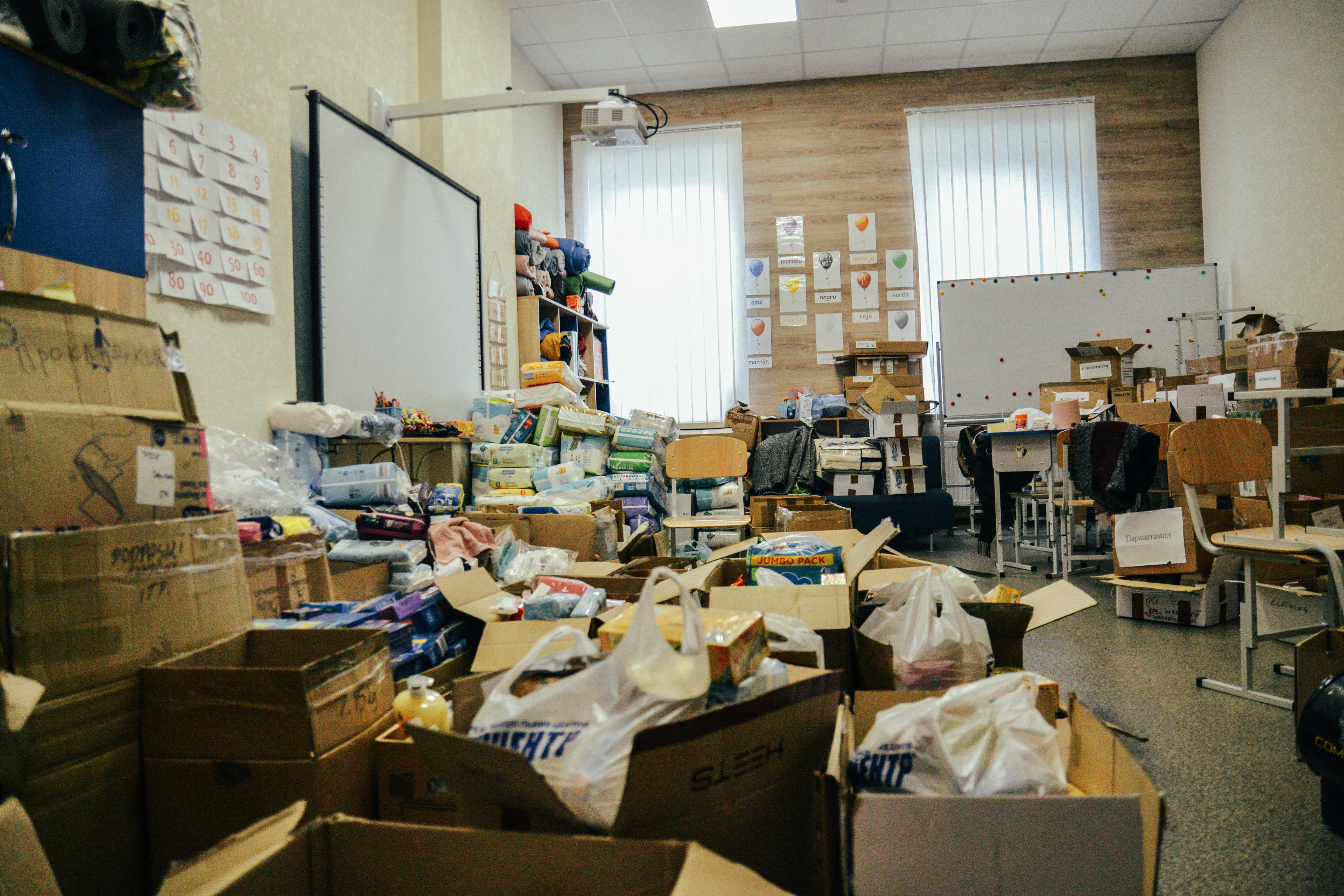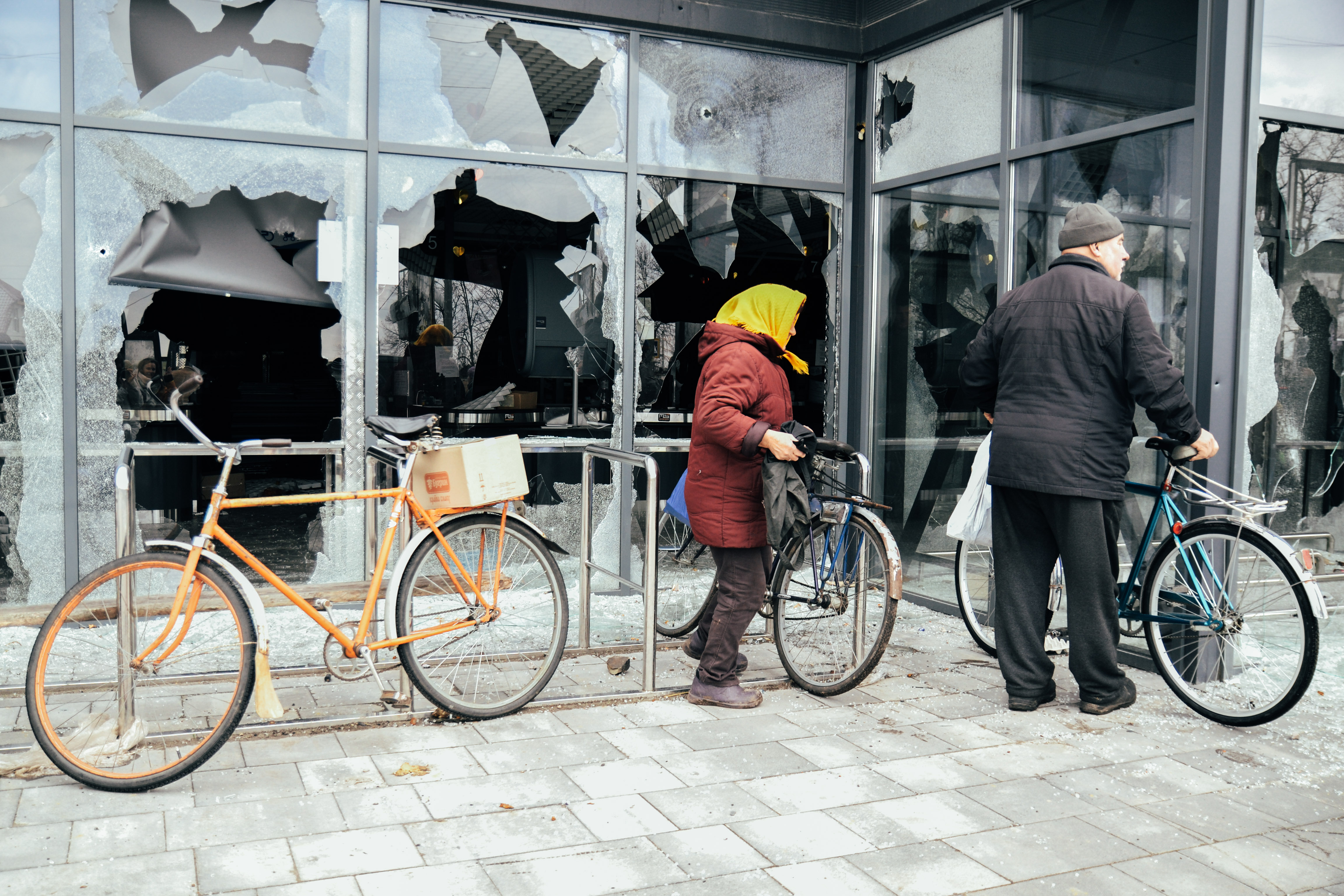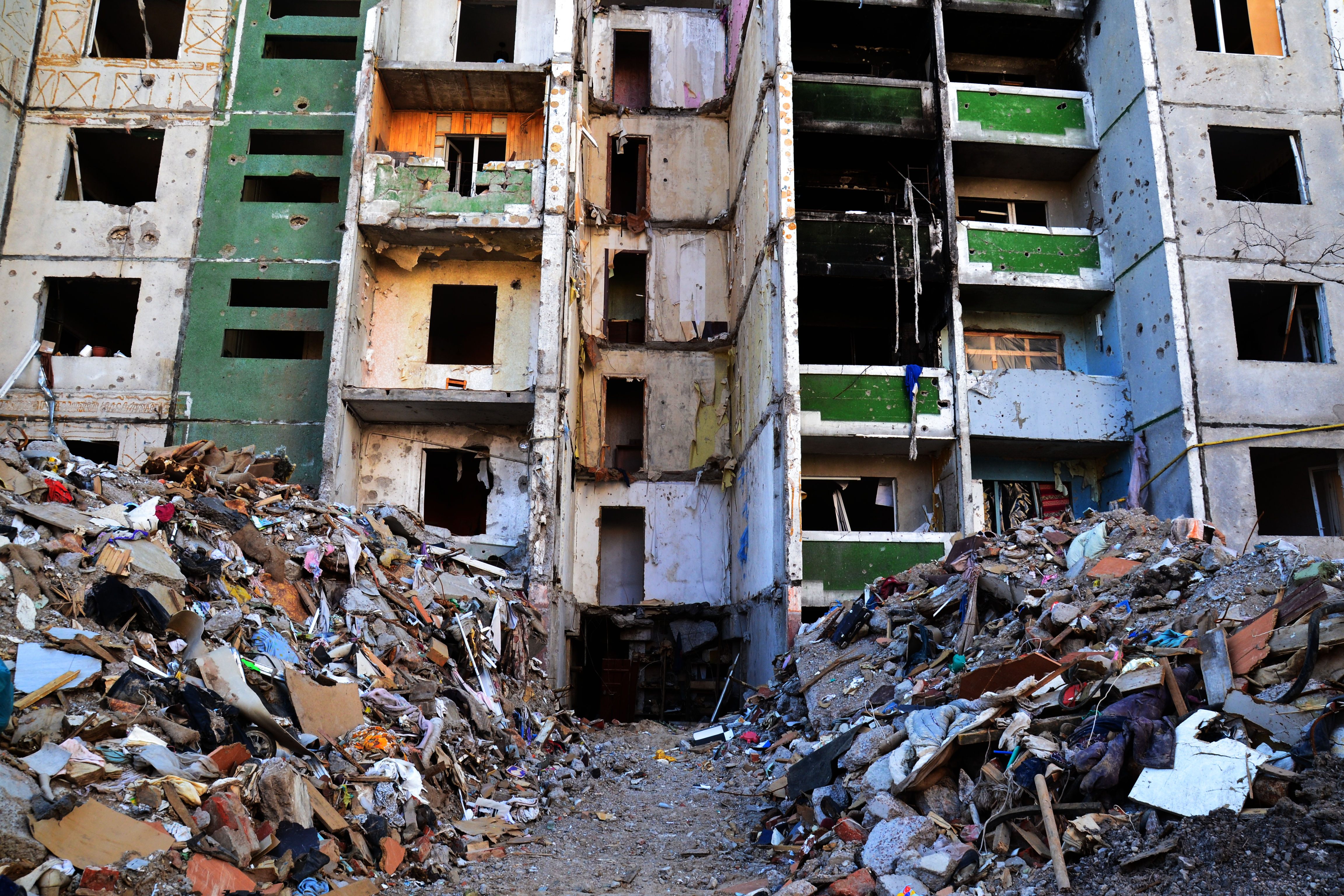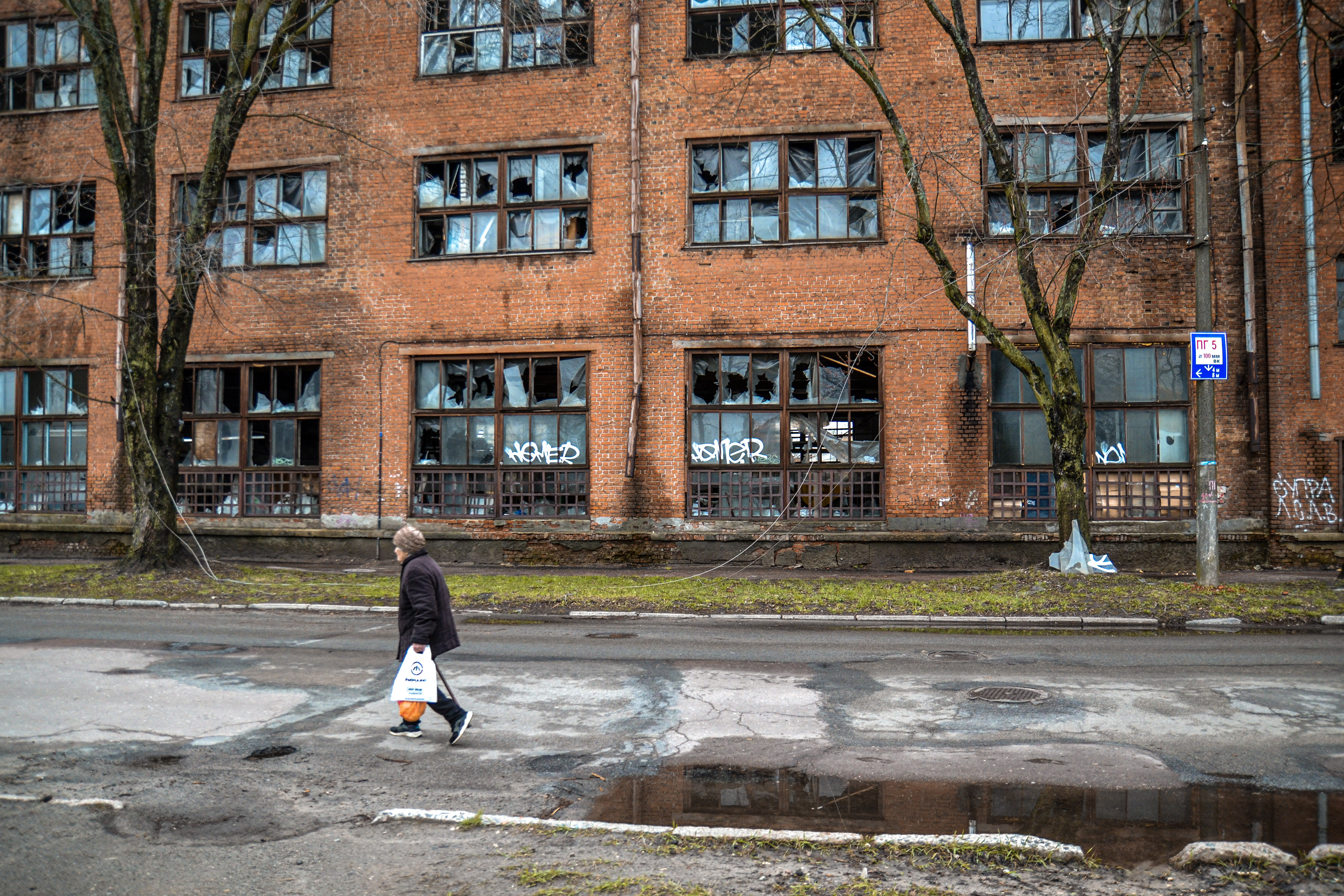A Woman sitting on a piece of ruin
Valentyna recalls her first living memory: the Second World War. She was two years old and was sitting in her private yard. This was a two-story house with two porches among sets of flowerbeds. The house is connected with an alley and a sand path.
The girl sat in her front yard and sees an aeroplane approaching. Perhaps she saw something similar later on in films, but she thought that the aeroplane was descending. Afterwards – blackness. Suddenly, her home was in ruins, and she saw someone run away. There was no more house, no parents anymore – only orphanages.
At the age of twenty years old, Valentyna was given a one-story house next to the road and next to the military base in Chernihiv, which she worked in. She was finishing rooms in her house on her own – sacrificed her holidays and travels just to be able to finish them, and for that dragged suitcases filled with things to sell abroad. ‘My entire life is based on suitcases, or perhaps the other way around – suitcases on me’.
Her house is well known around here. Valentyna loves flowerbeds so much that she covered the entire ground with them, along the sidewalk and road too. People who get off the trolleybus stop nearby always notice her flowers. She does her best to impress them.
Her area was the first to be shelled in the first days as soon as the Russian army approached the city. In the morning of the 2nd of March, she had just finished cooking soup and started making pancakes. She took a moment to walk out of the house to a soldier who was eating cold potatoes from a can. Valentyna invited him to eat something warm but he did not have the time.
Valentyna returned to the kitchen. She looked back on the street and took off her pan when she heard a large strike. The house suddenly shook and cracked all over.
Valentyna was hit by something on the head. Panicking, she held out her hand to touch her face to find blood. She ran to the door – it was knocked out and jammed the entrance (which was destroyed). ‘I’m here, I cannot exit’ – she exclaimed. Ukrainian soldiers, upon hearing her cries, led her out of the window.
The shelling continued. The soldiers took Valentyna by the arms and led her to an ambulance. The ambulance was just picking up an injured soldier. Valentyna was put next to the soldier and couldn’t think of anything else but hold the soldier’s hand. The ambulance arrived at a local hospital, but it was already destroyed. They left for another. Valentyna was taken from her house in her indoor clothes. In the hospital, she was given a warm sweater. She still wears it today.
Something sharp pierced Valentyna’s cheek. The doctor that stitched it together noticed another scar on her forehead. This was the scar from the day that her parents were killed by the aeroplane.
The next day, a medical vehicle brought the medical workers as well as patients, to the hospital. The driver noticed that Valentyna was wearing her indoor slippers while the outside was raging with winter cold. He decided to drop her off right at her house.
– Where is your house?
Valentyna did not know what to say. She started crying and said ‘That one, which is already gone’. A pile of bricks became her house.
The lifting of the Siege
Chernihiv is mostly a Russian speaking city, the centre of an oblast which borders Russia and Belarus. It is at most 2 hours by car to Kyiv from here, with a moderate speed of driving. In the times of the COVID-19 pandemic, the city was flourishing as even people from Kyiv immigrated here. The city is small, quiet, well looked after, with a developed infrastructure, newly reconstructed, has cheap housing and a great transportation system connecting it with the capital. Living here based on a Kyivan wage means living well off. A one bedroom apartment can be rented for only 2000 UAH.
Now, there are 101 high-rise buildings in Chernihiv that are completely destroyed. Another 500 are damaged by explosions and shelling. All in all, this is 37 thousand apartments. The city has 250 thousand inhabitants.
The biggest damage was taken by the suburbs. The Russian army surrounded the city and shot at it from nearby villages which were under occupation. The highest suffering was felt by the entrances to the city where the Russians tried to enter. Valentyna’s house was alongside one of these roads.
In mid-March, the Russians dropped a bomb on a bridge which connected Chernihiv with the capital. After this, the city was under full siege. During the heaviest shelling of the city, only half of its inhabitants remained there.
Three and a half hundred civilian inhabitants of Chernihiv died as a result of the constant shelling. Even more died from sickness, lack of food and care. Emergency services were often unable to reach people in some areas of the city. Nevertheless, none of the hospitals stopped working. The doctors continued their work thanks to the reserve generators. The same with the local morgue. The workers there constructed coffins from wood, asking for local carpenters for material. People were buried in the old and enclosed cemetery, because the central cemetery was constantly being shelled. The Russians have also struck the church of the cemetery, which served as a shelter for people.
Olya Palkova-Svirshevsksa has been a volunteer from the start of the war in Donbas in 2014. She put her volunteering activities to an end right before the big war. Olya has diabetes and thus it was time to take care of herself and her loved ones.
During the first days of the large-scale Russian assault, she maintained this mentality, until the moment she saw the Territorial Defence forces digging trenches from her window. From that moment, she and her husband grabbed shovels and helped with the trench construction.
Soon after, other volunteers as well as the government divided the city into several sectors, so that delivering food and water would be more practical. Now, when the need for food is not as critical, Olya and her friends have returned to volunteering for the needs of the military.

Communal services resumed. Plumbing services and gas pipe repairs were carried out under the protection of the military. For a few weeks, Chernihiv lived without water – its suburbs for even longer. Potable water was distributed by communal workers and volunteers. In the private industry sector, water sources were distributed to local inhabitants. Water was taken from two local rivers. The rivers were also used for washing clothes and showering. When it rained, buckets and bowls were brought out to collect rain near buildings. Some people keep their buckets at the ready, just in case.
In early April, when Russian forces were repelled, communal workers could not yet estimate how much time they would need to repair central pumps in order to restore the water supply to the city’s remaining buildings. Heating networks have been damaged so greatly that a fully repaired heating system would take about three years in the making.
Communal services in Chernihiv are considered to be heroes just as much as the famous drafted soldier who shot down a Russian airplane (which was severly bombing civillian infrastructure and the center of the city) over Chernihiv – who was in fact an ordinary worker for UkrPoshta (Ukrainian postal service).
The siege and the absence of communications can still be reminded to us by the self-made toilets and ovens on the street, which were constructed manually with bricks. The ovens were the main ‘kitchen’ during these hard times, used to feed entire blocks. For some of the inhabitants of Chernihiv, this is still a reality.
The mayor was becoming more reliant on the state budget rather than on the local one. He proposed the temporary cancellation of utility bills based on government subsidies. He also proposed the introduction of free public transportation in the city. However, these proposals never materialised. The people of Chernihiv, those who could, have already paid their communal and utility bills. For the moment, public transport is operating at a third of its original capacity as the fleet of vehicles used here was bombed when it was kept in its warehouse. For now, when the transportation issue has not been resolved, Chernihiv has become a cycling city.

Grand Opening, Soon
Lidiya Kushnir closed her small pet store during the first days when her area was struck with shells and her street became a defensive line for the military. The rest of the pet food was taken home – Lidiya had two grown up and two smaller Spaniels. She simply started to share her own food with the dogs. She also cooked for soldiers outside, delivering bread for those who were injured. Together with her dogs she helped search for people under ruined buildings on Chornovola street.
This was the place where the Russians struck with eight unguided missiles. The number of casualties grew every hour. Rescue teams reported 47 dead by the evening. A few days ago, another person was found under the ruins of a building there. Most of those who died were simply standing in line for bread and medication.

As soon as the Russians were repelled from the city, Chernihiv’s connection to Kyiv was repaired thanks to the usage of an old road known as ‘the old Kyiv road’. This was the road that was used by the first trucks carrying supplies to Chernihiv, thus giving the possibility of shops and other businesses to reopen.
Lidiya brings a few small boxes to her shop, along with bags of pet food and a litter box for cats. People are already waiting in line outside of her shop. Nevertheless, the shop looked empty compared to what it was like before. Lidiya is worried about the feasibility of paying rent and finding any ‘goodies’ for her dogs which she usually gives as extras to her clients. None of these past luxuries are abundant now.
Lidiya expects to bring her business back to normality within a few months. She is one of the few that reopened in her line of shops on the street. Next to her shop, a café has also reopened. It was supposed to be open for its first time in March, but due to the war, its sign ‘To be opened soon’ stayed up until April. Today, coffee is made there. As per agreement, there is a discount for those who visit the café with their dogs.
It is easier for small businesses to recover, according to Kostyantyn Ivanov, the president of the Chernihiv chamber of commerce. Small business started to come back to life in the first available days. On the first days after the lifting of the siege, the first café was reopened. Soon after, the first vehicle repair services were reopened, while the café had already begun giving bread along with its coffee.

A large portion of the trade in Chernihiv was done under shelling and rocket fire, until the moment electrical supply was shut. Large grocery stores continued to operate thanks to their backup generators.
In the meantime, larger industries for the most part, halted their operations during the peak of the conflict, according to Kostyantyn. He claims that around 90% are damaged. After all, it was the industrial zone, situated in the suburbs of Chernihiv, which suffered the most.
The Chamber of Commerce has taken a look at twenty of such factories. Despite the damage, all of them are slowly returning to functionality, even if not to their full capacity. ‘Some have lost raw material, some have lost their warehouse or machinery. The large producer of toilet paper here lost its main factory building and machinery but continued its production on a smaller scale. The agricultural sector has started its revival thanks to the work of deminers’.
There were other businesses which worked as long as the electricity supply remained in place. One of the local sewing shops restructured itself to serve the needs of the military – they have sewn tactical unloading packs. One of the major local producers of cans stopped its operations (even though it had a reserve of raw material for this) on the 19th of March.
‘The economy of the city suffered and continues to suffer. However, subsidies from the government are currently in place and supportive of key sectors for the time being’ – says Kostyantin.

Due to the fact that not all production is at its full capacity, not everyone has been able to return to work. Work is often the decisive factor of the question of whether to return or not.
Before the war, Anastasiya S. worked as a construction engineer at a large industry in Chernihiv, which she does not want to name in order to put the other workers in a bad spotlight.
A week ago, Anastasiya and her mother returned to the city after being previously evacuated. Her mother returned to work immediately as she had her own private business. However, Anastasiya’s employer halted her contract. For her, this means a complete absence of income. In fact, her employer only retained 30% of its previous workforce. ‘I really wanted to stay. This was my home, my entire family was here. However, I must now leave and search for work according to my background so that I can financially help my mother and grandmother’
Occupied villages
The Russians entered Chernihiv’s nearby villages in early March. Besides the locals, there were a lot of people from Chernihiv, which decided to move there after the 24th of February, as they thought that being outside of the city would be safer. This was a mistake. These villages were under occupation for more than a month.
An anonymous married couple from Chernihiv moved to one of their parents’ house in Ivanivka. The Russians entered Ivanivka on the 5th of March. They rolled through the central street and shot at people’s houses. The centre of the village was on fire for three days. People who have lost their houses, moved to other people’s houses. One house could sometimes be the refuge for up to 20 people.
A lot died from lung and heart problems. People were buried in backyards. According to the couple, sometimes, it was necessary to ask the Russian invaders for permission to go and relieve themselves outside.
After some time, men started disappearing in the village. After the Russians were forced out of the village, some were found dead, with bullet holes in their bodies.
People shared food and medication with one another. People didn’t shower and didn’t change clothes. The villagers managed to steal a few pigs from a local farm before the Russians got the chance to shoot them. In nearby villages, the Russians have similarly shot cattle. A few stolen pigs and salt saved many inhabitants of Ivanivka from an impending famine.
Everything that was reminiscent of anything military, was burned and buried. Searches in houses were always sudden and unexpected. ‘We were often dragged outside in the cold, and were kept under watch by someone who was armed. In the meantime, someone else would go inside our house and search through our things. They found my brother’s military certificate. They subsequently took my brother, tied him up and dragged him somewhere. Women from the street have attempted to get him back for four hours’ – the woman of the couple says. People are still scared of this repeating again.
Currently, many of the local inhabitants have nowhere to live or work. However, most agree that they are willing to stay as long as they have a roof to sleep under.
Nowhere to go
The wish of many young people to return to Chernihiv depends on whether their home was left intact. Two areas of the city were completely destroyed. And if someone has the means to fix their home themselves, it would be impractical for high-rise residential blocks, as the apartments of hundreds of families are practically gone altogether. The government has promised to construct two modular towns. However, there are many more people waiting to be placed there than there will be places available. Hence, younger families are keen to move out. Older families, pensioners in particular, are left puzzled as to how they will return all of the savings they accumulated their entire lives.
Valentyna also awaits her place in one of the modular towns as she lost her home and her flower beds that were next to the old military base. She waited out the epicentre of the battle at her friend’s place in a nearby village, which the Russians did not reach. A few weeks ago she returned to her home to find it in ruins. She also met one of her neighbours who said that there is a bomb shelter nearby which held around 300 people during the time of the bombings.
Currently, there are around 50 people in the bomb shelter who simply have nowhere to live. During the day, they go to their houses in an attempt to try to fix or rebuild parts of them. They are all united by the synchronous assembly and collective daily departures to the outside and carry out tasks such as collecting documents from the police. One document in particular – one that can ensure the reconstruction of their homes is in high demand. There dozens of bomb shelters like this in Chernihiv.

This bomb shelter until recently served as a training ground for local boxers. Now, it is cramped and everyone has their own square with a bed and blanket, as well as a place to hold their belongings. The ropes on the boxing ring now serve as a hanger for blankets, clothes and bed sheets. Life in bomb shelters beats like a drum. There are those who are responsible for food, others for cooking, delivery, radio, guards and commandants.
Valentyna still cries a lot. She is new here. She expresses her love for chiffon dresses, tulips, chrysanthemums and other plants as something from the past. Her home was her entire life. Here, underground, among the thick concrete in this massive structure, she doesn’t know how long she can last without her usual life of planting and flowerbeds all over the place.

